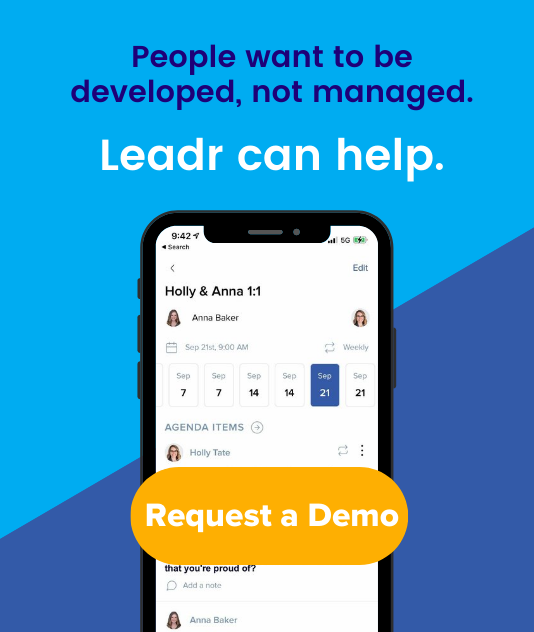Creating A Culture of Leadership Development
Creating A Culture of Leadership Development
As history has shown, leadership styles and decisions can make or break an organization. It’s a critical part of growth - an organization must have a visionary leader who can motivate, inspire, encourage and at times, course correct their team when needed. At the same time, a lack of leadership can lead to devastating results - demotivation, a lack of productivity, and low morale for an organization, or even the ultimate collapse of an organization.
But it’s also important to note that while leadership may begin at the top, it shouldn’t stop there. According to Forbes, leadership is a process of influence which maximizes the efforts of others, towards the achievement of a goal.
This means every department, team, and individual in your organization has the capacity to be a leader in some capacity. In order to be truly effective, good leadership should trickle down and be an integral part of culture. As a manager, you’re modeling leadership to your team every day, but you should also be unlocking the leadership potential in each of your team members.
At Leadr, we call this people development. We believe everyone has the potential for leadership and it’s just a matter of unlocking that potential in every member of your team. We’ve distilled the process into five approachable areas you can focus on in your organization to cultivate great leaders, no matter where they sit.
1. Have 1:1 meetings between managers and employees at least bi-weekly.
Gallup finds that “70% of a team's engagement is influenced by managers. Furthermore, the traditional role of a boss as a command-and-control function does not work for today's workforce. The expectation is for the manager to be more of a coach than a boss.”
People want to be developed, not managed. Employees are craving growth and development. Rather than looking at one on ones as a just time to check in on tasks, consider this as a time to create intentional space for growth, mentorship, and encouragement.
Absolve all else, one on ones should provide consistent rhythms of growth and development so that the employee feels heard and valued for their ideas, unique contributions and gifts, and feels like the one on one is an approachable space for them to bring issues and concerns to your attention.
Other tips for one-on-ones:
-
Make sure that you have a clear purpose set for the meeting and give your team members time to reflect or prepare for items on the agenda.
-
Personalize each one on one - conversations with each of your team members should look different depending on their learning style, pace of work, and communication preferences.
-
Set a cadence and stick to it. It’s critical to not cancel one on one meetings frequently. Organizational growth begins with individuals, so invest in people over projects and you’ll see productivity soar.
-
Remember: don’t let it devolve into just a project update meeting.
You may find that with time and intentional leadership like this, your team will learn to triage problems and take initiative on their own as they gain confidence in their leadership abilities. The goal of one on ones is to set your team up for success by providing the ideal space for you to give guidance, provide empowerment, a listening ear, and coaching at an individual level to each member of your team. As you do so, you’ll see your culture flourish as your team members become new leaders and share your vision and methodology of leadership with others.
For more on the essentials of an impactful one on one meeting, check out our free eBook.
2. Understand and recognize the unique strengths of your employees.
Each of your team members brings unique skills and gifts to your team. As a leader, it’s your responsibility to identify and celebrate your team’s strengths and develop their weaknesses. Why this matters:
-
Employee engagement - When an employee feels known, heard and valued by their workplace, your culture becomes irresistible. Of course, you may occasionally have to do jobs you don’t love, but overall people want to join in because they know it’s a place where they can contribute to projects that fit their passions and skills and their workplace provides a clear path towards that kind of growth.
-
Retention - When engagement is high, employees are much less likely to leave. According to Gallup, people who use their strengths every day are 15% less likely to quit their jobs. It takes 12 months on average for new employees to reach their full potential, so investing in your employees from the get-go is worth the effort.
-
Output - When people feel motivated and excited by their work, involved in decision making, and known by their leader, efficiency spikes.
As you lead, remember that what works for one person may not work for everyone the same way. An easy way to quickly identify individual strengths in each of your team members is through personality assessments. This blog outlines 4 tips on how use can use personality tests in the workplace as a leadership development tool. how each person brings value to the team inspires and motivates them to step up and lead on their own in areas where they feel strongest.
3. Provide your team with consistent and frequent feedback.
One of our favorite books at Leadr is The 5 Dysfunctions of a Team. In this book, Patrick Lencioni offers practical steps for overcoming the core challenges that teams face. The foundational issue he names is a lack of trust between team members. Practicing giving and receiving feedback on a regular basis creates opportunities for team members to engage in honest discourse.
Feedback is also critical for innovation and efficiency. Teams who are willing to share their ideas and speak up when things aren’t working will end up with better solutions, faster.
The key to feedback is ensuring it happens frequently and timely. Each team member should always know where their leader sees a need for improvement and where they are excelling and on track. Build feedback into the fabric of your culture by having team members ask for and give feedback in each meeting they attend. This turns feedback into a normal, expected behavior.
When feedback is a rhythm, it also helps your team build skills in receiving it well. Receiving feedback well is a learned behavior for most, and it permeates into your culture. It can help your team debrief on the good and the bad with agility and clarity on how to move forward without letting it shake their focus or confidence.
4. Clearly document goals
It’s critical for every organization, team, and team member to have clear, actionable goals, and each of these layers should all tie back to your organization’s mission. Discuss these goals often to hold each group accountable.
-
Organizational Goals - It’s important for your organization to have a clear mission that is known by every employee. Repeat your goals as often as possible during staff meetings or or displayed throughout your office as a continuous reminder of what every staff member should be reaching for. Revisit your goals frequently to ensure they still align with your mission and are being lived out by your team.
-
Team Goals - Every team should have goals that help reach the organization's goals. When creating goals, ensure each of them can be tied back to supporting the organization at large. Be sure you’re clearly documenting goals in an official capacity too - it aids in accountability and gives you a strong foundation for future conversations about growth and development - also crucial elements of your team culture.
To increase engagement and excitement around your team goals, you could even practice the post it note method - write down goals for the day or the week and have team members rip them up as they complete or reach the goals. It’s a visible reminder of progress.
-
Individual Goals - Finally, individual goals will be the most specific and tactical. Managers and team members should discuss these goals regularly during one on ones to ensure each employee is working on efforts that support their team and organization’s goals.
You want to have a record to look back at for each team member to give an accurate and fair assessment of their work and contributions. It may also help you identify those team members who are ready for the next step of leadership and gives you a jumping off point for their personalized growth.
Write your goals down and share them with others. Set clear expectations, build in feedback along the way, and zoom in and out on the goals regularly.
5. Develop a personalized growth plan
Developing each of your team members on a personal level is a crucial part of your culture of leadership. Teams are much more likely to succeed in meeting company and team goals when employee engagement is a focus, leading to a significant decrease in factors like turnover and absenteeism, and an increase in productivity. Overall, development programs foster new skills, encourage teamwork and collaboration, and could even help your meetings be more efficient and productive.
We’re often surprised when an employee is disengaged, yet we’ve failed by not giving them
something to strive toward through their own development plan. If you are looking to grow or improve your leadership development program, we’ve done the heavy lifting for you in our eBook, Your Guide To Building A Comprehensive Leadership Development Program.
Download it now for tips, timelines, and templates for building a program that engages and grows every person on your team.
The Transition From People Management To People Development
At Leadr, we believe in these five elements so much that we’ve made them of our Five Core Foundations and integrated them not just into our workplace but built them into our software too. Leadr’s people development software makes it easy to set and track goals, share learning opportunities with your team, give and receive feedback, and understand your team on a deeper level. Want to see Leadr in action? Request a demo with our team.
As you consider what it looks like to develop people rather than manage them, ask yourself, how are you developing leaders within your staff? Are you equipping them with the experience and resources they need to rise to grow? What step can you take today to begin investing in your people? Share your ideas with us. .png)
Share this
You May Also Like
These Related Stories

Building a Strong Team Culture: Virtual, In-Person, or Hybrid

Quiet Quitting - a Threat or an Opportunity?




No Comments Yet
Let us know what you think